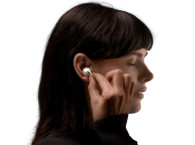
This trend to wireless audio is gathering speed. First Apple removed the 3.5mm jack back in 2016 in the iPhone 7. Other OEMs were clearly paying attention; in the second quarter of 2018, a record number of models switched to a more widely useful USB-C port in place of the jack. Today, 17% of handsets no longer offer a jack; in high-end smartphones, it seems likely the jack will disappear altogether. How do consumers prefer to connect today? The fastest growing component in after-market headphones is wireless (Bluetooth), easily gaining over Lightning, USB-C and jack attaches.
But there are challenges; with wireless audio it is challenging to manage audio quality (bass-boosting, equalization, etc.) as effectively, and if you’re listening through something other than a big headset with big earcups and perhaps noise cancellation, your audio experience will be compromised by background noise. Still, consumer expectations are based on what they want.
What does that take? Let’s start with noise cancellation. For in-ear headsets, there’s no big earcup for passive cancellation, so any solution has to be based on active noise cancellation (ANC). Some headsets offer ANC, either feedforward, picking up noise on the outside of the speaker to generate cancelling noise, or feedback, picking up noise between the speaker and the ear to generate cancellation, or a hybrid of both. Such solutions look attractive for wireless earbuds.
The time-tested solution to reduce size, power and cost is to integrate technologies, especially when this functionality needs to go in each earbud. A DSP-based solution running ANC software supported by tiny microphones inside and outside the speaker can run at very low power and can be integrated right alongside the speaker circuitry.
And once you have a DSP in each earbud, there are a number of other technologies that can also be easily added via software that can truly differentiate and improve the user experience. Adding advanced audio support like equalization is an obvious example, Support for voice-activated functions (“next song”, “call home” ...) provide other examples. Voice-activation becomes quite easy, given you only need very-near-field pickup through those same speakers and the voice-pickup software (again running on the DSP) can discriminate between the owner of the device and other nearby speakers.
Finally, what about that problem that caught many consumers by surprise in their “not-so-wireless” wireless headsets? Clearly what we consumers expect is individual earbuds with no additional wires – like the Apple Airpods. No amount of marketing spin is going to convince us otherwise. But that creates challenges for synchronizing between left and right speakers. This is a big part of why most solutions connect the earbuds – to manage that synchronization.
The reality is that it takes more work and more technology to manage synchronization otherwise. However, the Advanced Audio Distribution Profile (A2DP), as part of the classic Bluetooth, can overcome choppy connections by sending audio streams to both earbuds simultaneously, rather than the more common approach of sending audio to one earbud then having that recycled to the other earbud. This also further significantly reduces power consumption, another major gain in extending battery life on these tiny devices.
So when pondering “how do I deliver the form-factor consumers want in wireless earbuds, with high-quality ANC, with hi-quality features like equalization, with voice-activation and with extended battery-life?” maybe the answer is designing your next product around an embedded DSP and Bluetooth low energy.
About the author
Youval Nachum is CEVA’s Senior Product Marketing Manager for audio and voice product line.
Read more about CEVA audio and voice development solutions here







